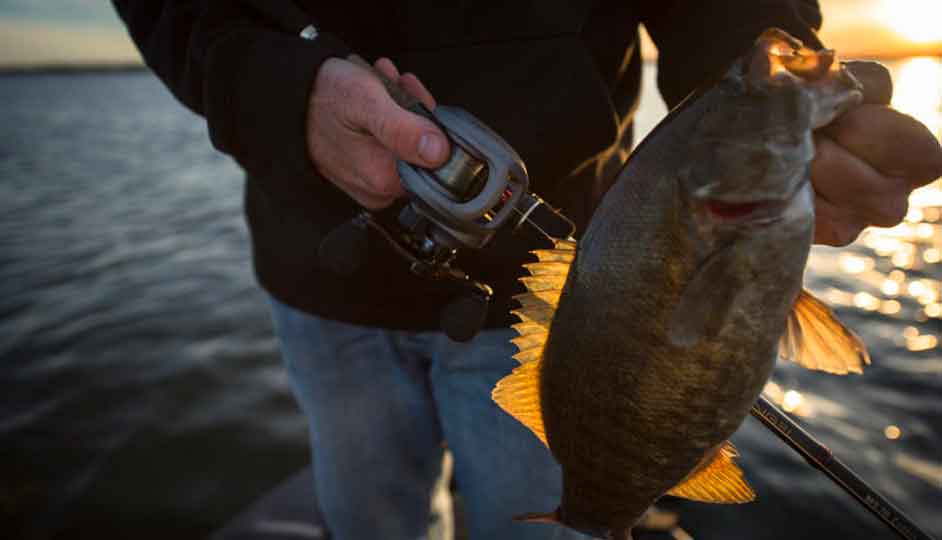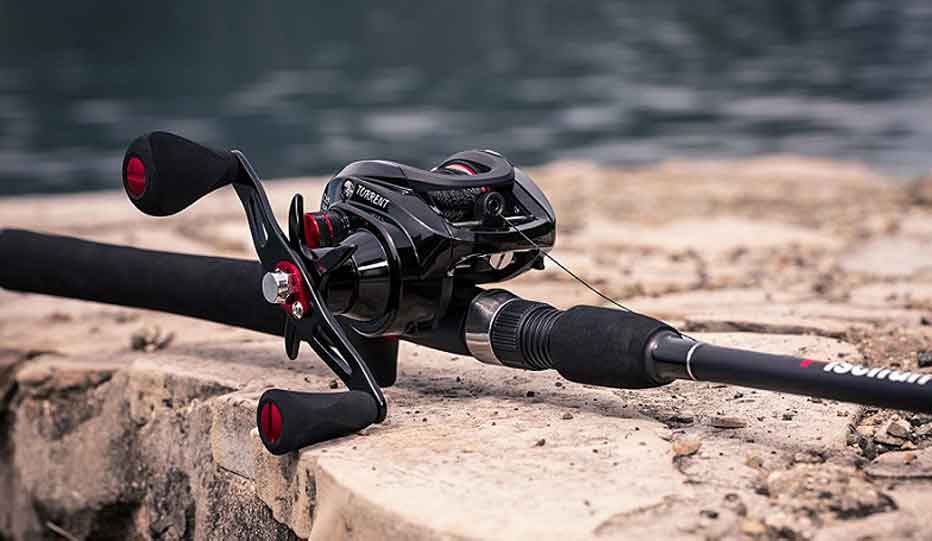
In the beginning, most of the anglers use their traditional spinning gear and that’s the most efficient way to start but with the time you will understand the fishing and it rules. The more time you will spend, you will be more confident and slowly understand the efficiency of baitcast.
Baitcast looks complicated, intimidated and they probably are complicated than even the best spincast reel. But, Baitcasters are most adaptive equipment and their technology allows them to cast faster than any other reel.
How to Cast a Baitcasting Reel With Right Gears
There’s a possibility of failure in the first few tries, we will learn about the whole procedure of casting a baitcasting reel but first talk about choosing the right equipment-
Choosing the Right Baitcasting Reel for Better Casting
Choosing the right gear for the baitcasting is winning half of the battle. There’s few think to notice before buying a baitcasting reel.
Find the Right Gear Ratio
The first things we need to know is the right gear ratio it determines the speed of your lure retrieves. The spool turns over every time handle rotate and that’s gear ratio. For making the selection process easier most reels have the ration in their body.
If the body shows 5:1 ration than it means if the spool turns five times in one handle rotation. So, the higher the first number and the faster retrieve.

5:1 ratio is considered average but 4:1 is slow and 6:1 or higher than that is fast. Sometime ratio depends on the lure type. For larger lure slower retrieve and for soft lures average but for spinnerbaits or buzz baits need a fast gear ratio.
Choosing Spool Size for Proper Casting
The reel’s spool size is the next category. If we are targeting larger and stronger fish we need heavier line and that will take up more space on the spool. A reel that has a deep spool can hold the line even if it’s too long.
Sometimes extra line needed when it comes to catching a larger fish. That means larger fish need larger spools. A lighter line in bass fishing or walleye fishing can cost versatility and casting accuracy.
So the spool size needs to be smaller here. Moreover, the spool size depends on the fishes size.
Choosing Right Bait
Bait mainly depends on the type of fish you are targeting and what kind of fish you are fishing. Bait doesn’t differ for any kind of reel it always anglers choice.
How to Cast a Baitcasting Reel with Comfort
Comfort is most important when you are buying a baitcaster. If your hand doesn’t feel comfortable with the baitcaster there’s a possibility it won’t work.
A comfortable baitcaster will have a good grip and well-balanced rod-and-reel combination which will help cast with more accuracy.
You have to cast hundred times in one single outing so take the time and try out multiple reels and test out the mechanisms like thumb latches, reeling handles, drug settings, and other features.
Before buying the one try as much as an option you possibly can try that will give a clear idea about what to buy.
Choosing Right Baitcasters
Choosing the right reel isn’t the only solution for better performance in fishing in a lake or river in different countries. You need other items in proper shape as well.
Choosing the right baitcaster is one of the most important steps in baitcasting. There’s mainly two types of baitcaster-
- Magnetic
- Centrifugal
1. Magnetic baitcasters
Magnetic baitcasters seems like a good choice because of their adjustable knob on the outside o the reeling systems. But, it’s not because it has a higher backlash which removes all the advantages of approachability.
2. Centrifugal Baitcasters
Centrifugal baitcasters have the same braking system as a car. The breaking system normally located under the side plates and it can be adjusted by the interior pins. Pins can engage and disengage.

They can be pushed towards either towards or away from the center.
It’s a far better system than magnetic baitcaster. The model’s pins are like levers so beginner doesn’t have any problem casting them.
Casting with Proper Fishing Line
Line depends on the anglers choice but there are four kinds of the line is famous for baitcaster reels.
Fluorocarbon Fishing Line
Fluorocarbon’s main advantage is they are sensitive and invisible underwater. It is also good fly fishing line to use with right bait-casting.
Fluoro can be used a variety of situation but they work best in clear water, in sunny weather, stationary fishing line and with the lures like lizards and worms. But fluoro can give backlash when used in baitcasting.
Monofilament Line
Monofilament main advantage is it’s easy to handle so for a newbie its a blessing. Another thing is it’s cheaper and break easily, give less backlash.
Braided Reel for Baitcasting
A braided line has better durability, abrasion resistance and it’s best for heavy cover/ growth and difficult conditions. But handling It can be hard because of backlash.
Fusion for Better Casting
Fusion line is a combination of sensitivity and strength. They are easy to handle and can handle the weight.
Choose a Lightweight Rod
For baitcasting, a normal basic rod can do the job. You can always choose graphite rod which is more lightweight and work best in withstanding shock.

If you compare graphite with fiberglass rods, you will see fiberglass are slightly heavier and very durable.
Rods are quite flexible and they can compromise rod action. That’s why most of the anglers choose fiberglass over graphite.
How to Cast a Baitcasting Reel Properly
Practice baitcasting at home and it will help you in real life. Doing this at home will give you the confidence to start using baitcasting.
1. Locate your Braking System
The braking system controls the spool at the important point so your bait fly. It is one of best way for casting the baitcaster. If spool spins faster than the dispersing line then backlash happens. This backlash prevents when breaking system control or slows the rotation at the end moment.
So before using the bait cast find the braking system and remove its side plate opposite which is side platted opposite of the reel’s handle. If you are using magnetic then it’s not a complicated problem for you, all you have to do is simply adjust.
2. Choosing the Fish Location
At the beginning when you cast, cast it away from the water and replace your bait or lure with something different like rubber practice plug or metal sinker. Practice in an open area it will give you a more clear idea.
Avoid any area which has overhead bush it can create a problem the bait can get caught in the branches. It can cost your time to bring the rod forward to cast and choose a place with a minimal bush.
For baitcasting choose a place with fewer people, because if you are casting with other people you always have to worry about your lure. This will take away all the fun of angling.
3. Adjust your Braking System
Engage your brake but pushing the interior levers towards or disengage them so the braking levers will be away from the center and by doing this you will adjust the braking system.
But backlash can happen if you disengage the brakes.
4. Adjust Tension Knobs
The handle of the reel is on the same side as tension knob and tension knobs help spool to increase tension. Tension knobs work at the end of the cast when they bring the spool.
If you turn the knob clockwise it will tighten your tension knobs. The tension knobs adjusting depends on how much weight was carried by your baitcaster.
5. Test Your Tension
Baitcasting reels have a mechanism that disengages the spool from the handle which allows longer cast and they don’t turn during the cast.

Now for testing the tension check if your reel has a button behind the spool then press it with your thumb and then rest it on the reel spool. Start adjusting the tension knob so your bait falls gently and don’t make any backlash.
6. Grip Your Baitcaster
Grab your baitcaster bend your casting arm at the elbow so it has the right angle. Your hand should be wrapped around the rod handle and the reel.
This will ensure your thumb is resting on both the spool and spool release button.
This will ensure your hand’s perfect position and allow you to disengage your spool.
7. Release Your Line
Release with the good amount of line so it makes a good cast. There’s so many advice you will find for the length of the reel. But it’s better to have 8-12 inches of line to hang before the cast but if you have a caster or bobber attached the line should be 6-12 inch.
The line should be measured from the tip of the rod to the bait. Baitcasting rods and spin casting rods are same design so if you use the hand to hold the rod behind the reel then you may have to switch the hands when you cast.
Because most anglers use the same hand for cast and retrieve.
8. Release Your Spool and Cast
Press the spool release button and it will release the spool. To prevent the line from running you have to press the button again.
If you don’t do that line can make your bait hit the water and it will be an overrun or “bird nest” and it will take time to straighten the line to retrieve the lure. In the beginning, use heavy brake that will help you create shorter cast which will prevent casting too hard.
Practice a new hand position that will make baitcasting fun. Try to experiment more so you will know what makes you comfortable.
Last Few Words
Baitcasting was first discovered in the mid-17th century and people started using them in the late 18th century. They are used for every large kind of fish in sweet water.

Baitcasting needs practice otherwise you won’t enjoy fishing using them but if it’s learned properly than it can be fun and efficient. Baitcasting offers the most versatile option for fishing and a quality baitcaster can make a huge difference when you are catching fish.
Being quick while catching fish with baitcaster is also a piece of good advice, there’s million advice you will find on the net. Probably the best advice is just start fishing and rest you will learn in the lake or river when fishing.
Other Sources
Looking at the bluest sky, I forget all my stresses. Going through the green I try to breathe, more than I do in my reality. So, that’s why I love camping.
Leave a Reply